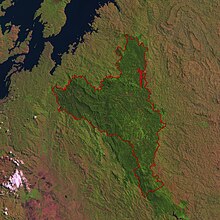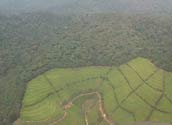Nyungwe Forest





The Nyungwe Forest (/nj-ʌŋ-ɡwɛ/) is located in southwestern Rwanda, on the border with Burundi, where it is contiguous with the Kibira National Park to the south, and Lake Kivu and the Democratic Republic of the Congo to the west. The Nyungwe rainforest is probably the best preserved montane rainforest in Central Africa. It is located in the watershed between the basin of the river Congo to the west and the basin of the river Nile to the east. From the east side of the Nyungwe forest comes also one of the branches of the Nile sources.
Nyungwe Forest National Park was established in 2004 and covers an area of approximately 970 km2 of rainforest, bamboo, grassland, swamps, and bogs. The nearest town is Cyangugu, 54 km to the west. is located within the park borders. In October 2020, the Rwanda Development Board signed an agreement with African Parks to assume management of Nyungwe National Park for an initial 20 years.[1]
Animal life[]
The Nyungwe forest has a wide diversity of animal species, making it a priority for conservation in Africa. The forest is situated in a region in which several large-scale biogeographical zones meet and the variety of terrestrial biomes provides a great span of microhabitats for many different species of plants and animals.
The park contains 13 primate species (25% of Africa's total), 275 bird species, 1068 plant species, 85 mammal species, 32 amphibian and 38 reptile species. Many of these animals are restricted-range species that are only found in the Albertine Rift montane forests ecoregion in Africa. In fact, the number of endemic species found here is greater than in any other forest in the Albertine Rift Mountains that has been surveyed. The forest, which reaches its maximum altitude of 3000 meters above sea level, is of particular interest for the presence of colonies of chimpanzees (Pan troglodytes) and Angola colobus (Colobus angolensis), the latter now extinct in Angola for the intense hunt to which they were subjected.[2]
History[]
From 1958-1973, Nyungwe was reduced by over 150 km² due to fires, woodcutting, hunting of animals, and small-scale agriculture. Nearby Gishwati and Virunga forests were cut in half at this time. In 1969, elephants still numbered in the hundreds in Nyungwe. In 1974, the last buffalo was killed in Nyungwe by hunters. In 1984, Nyungwe was divided into areas that allow for sustainable use and harvesting of timber. The Government of Rwanda develops a plan for a buffer zone that can still be seen today. In 1984, biodiversity surveys conducted by the Wildlife Conservation Society (WCS) with RDB documented colobus in groups of up to 400 members—an unheard of phenomenon. In 1987, development of the trail system began at Uwinka.In 1994, war and genocide devastated the country and destroyed many of the research and tourist facilities in Uwinka. Most senior staff were forced to flee, but many junior staff members at Nyungwe stayed on to protect the park. The park began to rebuild in 1995, but security and stability were still uncertain. In 1999, the last elephant in Nyungwe was killed in the swamp by poachers.
In 2005, the Rwandan Government makes Nyungwe an official National Park, giving it protected status, the highest level of protection in the country.[3]
Primate species[]

- Common chimpanzee (Pan troglodytes)
- Ruwenzori colobus (Colobus angolensis ruwenzori)
- L'Hoest's monkey (Cercopithecus l'hoesti)
- Silver monkey (Cercopithecus doggetti)
- Golden monkey (Cercopithecus kandti)
- Hamlyn's monkey (Cercopithecus hamlyni)
- Red-tailed monkey (Cercopithecus ascanius)
- Dent's mona monkey (Cercopithecus denti)
- Vervet monkey (Chlorocebus pygerythrus)
- Olive baboon (Papio anubis)
- Grey-cheeked mangabey (Lophocebus albigena)
References[]
- ^ "Rwanda, African Parks commit to long-term protection of Nyungwe National Park".
- ^ "Nyungwe Forest National Park In Rwanda". Kubwa Five Safaris. Retrieved 2020-10-19.
- ^ "Nyungwe National Park > Visit Africa". visitafrica.site. Retrieved 2021-04-20.
- "Nyungwe Nziza Project website for Nyungwe National Park". Nyungwe Nziza Project. Retrieved 2011-07-29.
- "Nyungwe National Park". Wildlife Conservation Society. Archived from the original on 2007-08-04. Retrieved 2006-05-25.
- "Nyungwe National Park, Rwanda". NASA Earth Observatory. Archived from the original on 2004-04-03. Retrieved 2006-05-25.
External links[]
- Western Province, Rwanda
- National parks of Rwanda
- Forests of Rwanda
- Protected areas established in 2004
